Common Names: Hardy kiwi; tara vine; kiwiberries; Siberian Gooseberry; Bowerberry (Hale & Connolly, 2014).
General Information: Hardy kiwi is a dioecious plant where male and female parts grow on separate plants. There are at least 6 different genetic variations of A. arguta worldwide and it is impossible to tell the difference based on appearance alone (Drzewiecki et al., 2015). One of the main reasons this plant is invasive is the lack of natural predators and ability to grow throughout large areas, overtaking forests and and native trees. The plant is able to grow in temperatures below 10 degrees Fahrenheit unlike the commercial cousin A. deliciosa which is a mostly tropical plant (Mattern, 1993).
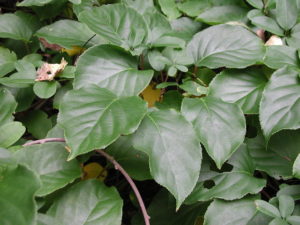
Leaf shape and physical appearance of A. arguta. © Les Mehrhoff
Leaves: In spring, each node produces a single leaf which typically grow in an alternating pattern along the bark. Alternate leaf orientation is when the leaves grow on alternate sides along the bark. The leaves are never directly across from each other but appeared more staggered in positioning. The petiole, or leaf stem, is typically red in color and very distinct when viewed up close. Leaves are usually 3-5 inches in length and the leaf design is simple which implies that the leaf is usually one whole blade rather than divided into smaller blades. Lastly, the leaves tend to stay green into late autumn and occassionally turn yellow right before dropping.
Bark: Young kiwi vines are smooth, light brown-red to grey-white. It 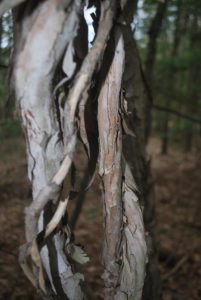
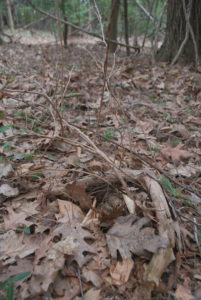 is often times easy to confuse them with another invasive vine, Oriental Bittersweet (Celastrus orbiculatus). However as the vine grows and matures, it becomes mostly grey-white and much of the bark begins to peel off or shed. Older bark may appear white or a faint grey color and may resemble the bark of the native wild grape. They also have vertical lenticels which are porous tissues that allow for the exchange of gases in plants.
is often times easy to confuse them with another invasive vine, Oriental Bittersweet (Celastrus orbiculatus). However as the vine grows and matures, it becomes mostly grey-white and much of the bark begins to peel off or shed. Older bark may appear white or a faint grey color and may resemble the bark of the native wild grape. They also have vertical lenticels which are porous tissues that allow for the exchange of gases in plants.
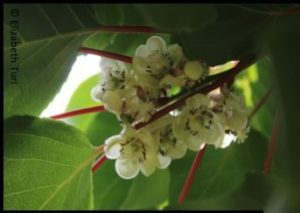
Cluster of A. arguta flowers. Copyright: Elizabeth TuriSingle A. arguta flower. Copyright: Dr. Alhert Schmidt
Flowers: Flowers of the hardy kiwi grow between the leaf and stem joint. The flowers are white in coloration with five petals and sepals. The flowers are approximately 1 inch in diameter but may be smaller or larger depending on the soil and growing conditions. The flowers usually bloom in June or July and typically last a few weeks.
Fruits: Hardy kiwi fruit has a smooth skin that can appear either green or brown in color. The fruits are approximately 1 inch in length and resemble a miniature version of the commercial kiwi fruit that can be bought in grocery stores. Inside the fruits is a green center with numerous little black seeds.
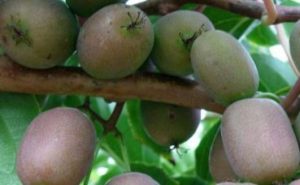
Native Range:Northeast Asia including western China and the Himalayan Mountain region; Japan
Current Range: Kiwi is well documented in Kennedy Park and Pleasant Valley Wildlife Sanctuary in Lenox, Massachusetts, in Stockbridge, Massachusetts, and Coffin Woods, Long Island, New York; it has also been documented in Oregon, Pennsylvania, Minnesota, Maine, and is thought to be in other states but records are not as thorough. (Demchak, 2013). Additionally, the plants are currently being grown in Belgium, Poland, and Switzerland where more research is being conducted on the morphology, physiology, and phenology (Cossio, Debersaques, & Latocha, 2015).
Locations where A. arguta have been sighted and confirmed worldwide. This plant is native to Northeastern Asia and China yet is being found in central Europe and the eastern United States and into northern Canada. © Les Mehrhoff
Literature Cited:
Cossio, F., Debersaques, F., & Latocha, P. (2015). Kiwiberry (Actinidia Arguta): New Perspectives For A Great Future. Acta Horticulturae, (1096), 423-434. doi:10.17660/actahortic.2015.1096.51
Demchak, K. (2013, March 22). Hardy Kiwifruit: Invasive Plant Or Throwback to the Gilded Age? (Tree Fruit Production). Retrieved March 26, 2017, from http://extension.psu.edu/plants/tree-fruit/news/2013/hardy-kiwifruit-invasive-plant-or-throwback-to-the-gilded-age
Drzewiecki, J., Latocha, P., Leontowicz, H., Leontowicz, M., Park, Y. S., Najman, K., . . . Gorinstein, S. (2015). Analytical Methods Applied to Characterization of Actinidia arguta, Actinidia deliciosa, and Actinidia eriantha Kiwi Fruit Cultivars. Food Analytical Methods, 9(5), 1353-1366. doi:10.1007/s12161-015-0309-1
Hale, I. L., & Connolly, B. A. (2014). Actinidia arguta (Actinidiaceae): A new record of a naturalized introduction in Connecticut. Rhodora, 116(967), 352-355. doi:10.3119/14-01
Mattern, V. (1993, January). Hardy kiwifruits. Organic Gardening, 40(1), 60. Retrieved March 26, 2017, from Agriculture Collection.c
